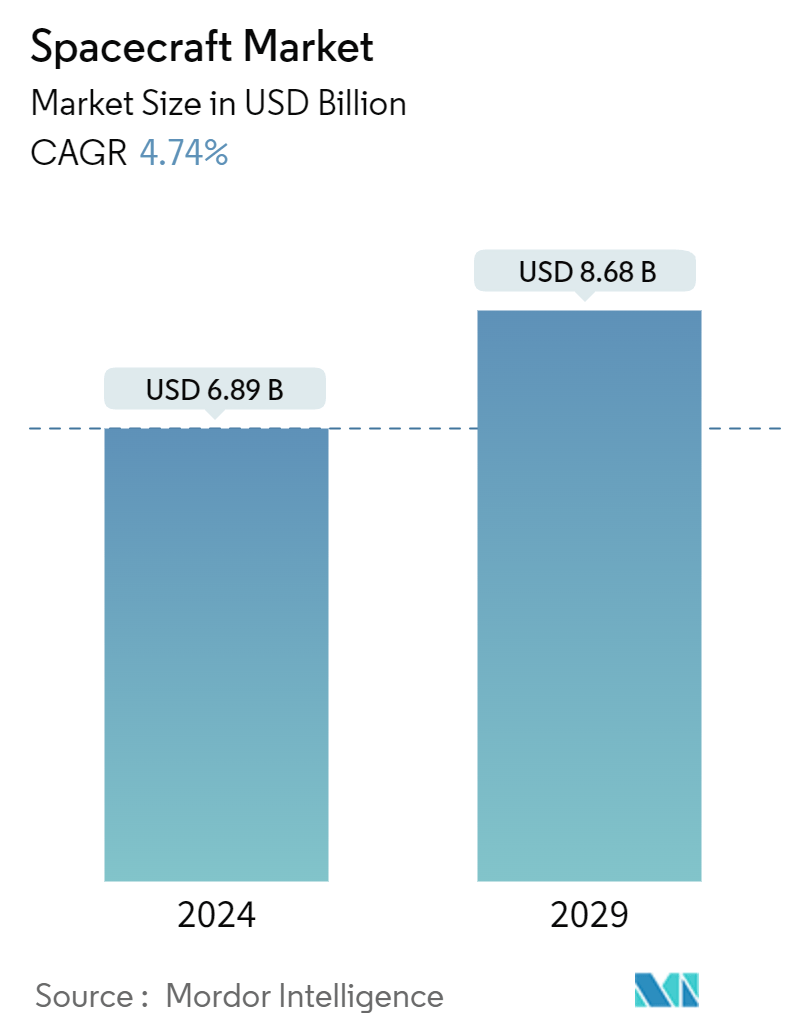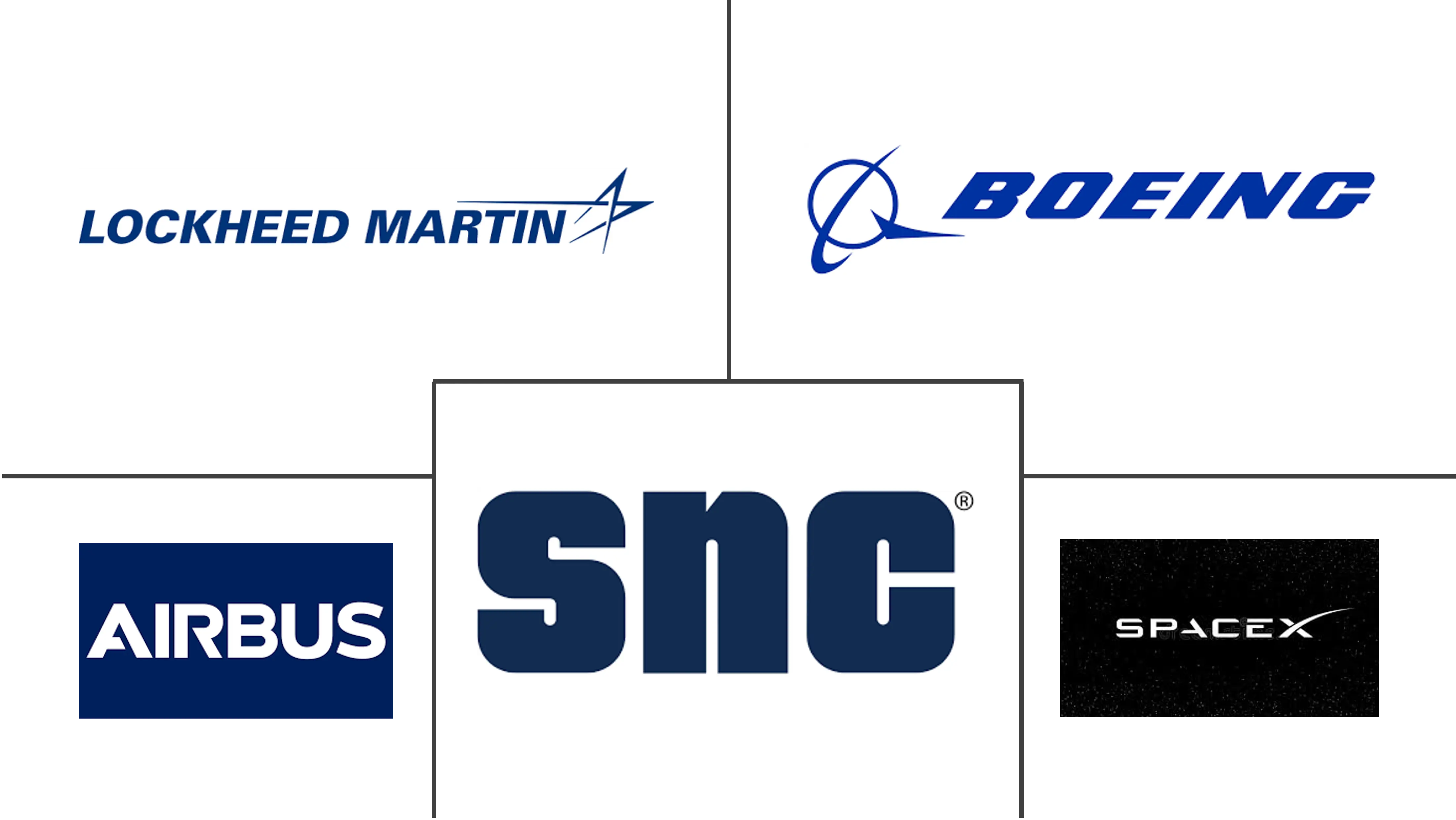Market Size of Spacecraft Industry

| Study Period | 2019 - 2029 |
| Market Size (2024) | USD 6.89 Billion |
| Market Size (2029) | USD 8.68 Billion |
| CAGR (2024 - 2029) | 4.74 % |
| Fastest Growing Market | Latin America |
| Largest Market | North America |
Major Players
*Disclaimer: Major Players sorted in no particular order |
Spacecraft Market Analysis
The Spacecraft Market size is estimated at USD 6.89 billion in 2024, and is expected to reach USD 8.68 billion by 2029, growing at a CAGR of 4.74% during the forecast period (2024-2029).
Various countries globally are increasing their investments in space exploration and commercial and military applications, which is expected to continue driving the growth of the spacecraft market during the forecast period. Various players in the market in countries like China, the United States, India, and major European countries are collaborating on developing advanced space projects, which are expected to generate demand for new space vehicles over the coming years.
- The rapid increase in funding for space entrepreneurs is due to governments spending heavily on establishing a strong footing for the growth of the space economy. The surge in funding is mainly due to geopolitical uncertainties, given that government agencies are using satellite imagery and data for everything from analyzing weather patterns or agriculture to movements at global borders.
- The development of advanced technologies has led to the miniaturization of spacecraft components and a reduction in overall manufacturing costs, which may support future market growth. Components that can perform the same functions while taking up less space and mass are needed. Manufacturers may explore microaturization techniques such as microelectromechanical systems and nanotechnology. In addition, manufacturers can improve the efficiency of solar panels by using advanced photovoltaic materials, optimizing cell design, and implementing tracking mechanisms to maximize exposure to sunlight.
Spacecraft Industry Segmentation
A spacecraft is a vehicle used in outer space to support various applications, such as communications, navigation, earth observation, space exploration, meteorology, and transportation of humans and cargo. The market includes satellites, cargo transporters, and human and crew spaceflight.
The market is segmented by type and geography. By type, the market is segmented into manned and unmanned spacecraft. The report covers the market sizes and forecasts for the spacecraft market in major countries across different regions. For each segment, the market size is provided in terms of value (USD).
| By Type | |
| Manned Spacecraft | |
| Unmanned Spacecraft |
| By Geography | |||||||
| |||||||
| |||||||
| |||||||
| |||||||
|
Spacecraft Market Size Summary
The spacecraft market is poised for significant growth over the forecast period, driven by increased global investments in space exploration and the development of commercial and military applications. Key players in countries such as China, the United States, India, and major European nations are collaborating on advanced space projects, which is expected to boost demand for new space vehicles. The market is also experiencing a surge in funding for space entrepreneurs, fueled by government spending aimed at establishing a robust space economy. This funding is largely a response to geopolitical uncertainties, with satellite imagery and data becoming crucial for various applications, including weather analysis and border monitoring. Technological advancements have led to the miniaturization of spacecraft components, reducing manufacturing costs and supporting future market expansion. The unmanned spacecraft segment is anticipated to maintain its dominance, driven by increased expenditure on the space sector and a rise in satellite launch programs globally.
North America is expected to lead the spacecraft market, supported by substantial investments in space programs and a growing number of satellite launches for both commercial and defense purposes. The United States, in particular, has the highest space expenditure globally, with significant contributions from private companies like SpaceX. Canada is also enhancing its space capabilities, focusing on advanced spacecraft development for various missions. The market is characterized by fragmentation, with prominent players such as Boeing, Airbus, Lockheed Martin, and SpaceX, alongside emerging startups. Strategic collaborations, like NASA's commercial crew program, are facilitating technology transfer and increasing competition. Recent developments, such as Japan's lunar mission and Sierra Space's Dream Chaser shuttle, highlight ongoing efforts to reduce launch costs and expand mission frequency, further driving market growth.
Spacecraft Market Size - Table of Contents
-
1. MARKET DYNAMICS
-
1.1 Market Overview
-
1.2 Market Drivers
-
1.3 Market Restraints
-
1.4 Industry Attractiveness - Porter's Five Forces Analysis
-
1.4.1 Bargaining Power of Buyers/Consumers
-
1.4.2 Bargaining Power of Suppliers
-
1.4.3 Threat of New Entrants
-
1.4.4 Threat of Substitute Products
-
1.4.5 Intensity of Competitive Rivalry
-
-
-
2. MARKET SEGMENTATION
-
2.1 By Type
-
2.1.1 Manned Spacecraft
-
2.1.2 Unmanned Spacecraft
-
-
2.2 By Geography
-
2.2.1 North America
-
2.2.1.1 United States
-
2.2.1.2 Canada
-
-
2.2.2 Europe
-
2.2.2.1 United Kingdom
-
2.2.2.2 Germany
-
2.2.2.3 France
-
2.2.2.4 Russia
-
2.2.2.5 Rest of Europe
-
-
2.2.3 Asia-Pacific
-
2.2.3.1 China
-
2.2.3.2 India
-
2.2.3.3 Japan
-
2.2.3.4 South Korea
-
2.2.3.5 Rest of Asia-Pacific
-
-
2.2.4 Latin America
-
2.2.4.1 Brazil
-
2.2.4.2 Rest of Latin America
-
-
2.2.5 Middle East and Africa
-
2.2.5.1 Saudi Arabia
-
2.2.5.2 Turkey
-
2.2.5.3 Egypt
-
2.2.5.4 Rest of Middle East and Africa
-
-
-
Spacecraft Market Size FAQs
How big is the Spacecraft Market?
The Spacecraft Market size is expected to reach USD 6.89 billion in 2024 and grow at a CAGR of 4.74% to reach USD 8.68 billion by 2029.
What is the current Spacecraft Market size?
In 2024, the Spacecraft Market size is expected to reach USD 6.89 billion.

